|

by Andrew Collins
from
AndrewCollins Website
|
British
historian Andrew Collins is the author of GATEWAY TO
ATLANTIS, which in 2000 proposed that Cuba was the
flagship of Plato’s island empire. He reports on the
recent discoveries of a lost city off Cuba, and its
importance to the Atlantis legend. |
Readers will be aware of the discovery deep beneath the Yucatan
Channel, off the coast of Guanahacabibes in western Cuba,
of what is purportedly a lost city. Hi-tech sonar equipment aboard
the ’Ulises’, a vessel owned by Canadian firm Advanced Digital
Communications (ADC), detected a several-kilometer square
area of what appear to be roads, pyramids and other building
structures at a depth of 2,200 feet. Yet it was not until July 2001
that Paulina Zelitsky, the Russian-born leader of the
expedition, got a chance to view the site first-hand.
A remote operated video (ROV), dispatched to the ocean
floor, sent back frustratingly poor quality footage of linear stone
features and large stone blocks, their sides and edges worn
away by the actions of the sea. What had ADC found, and was it
connected in some way with the legend of lost Atlantis, as
described by the Athenian philosopher Plato more than 2,350
years ago?
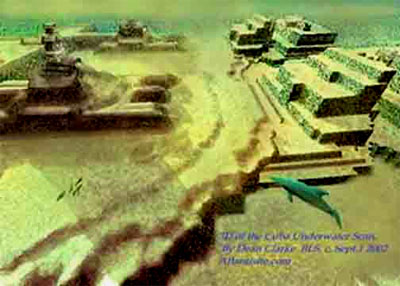
One man’s interpretation of Cuba’s
underwater pyramid located in the Yucatan Channel. This 3D image
was created by Dean Clarke of Atlantisite.com after he
studied the deep-sea sonar image released to the world.
The Myth of
Atlantis
Atlantis was said to have been an island empire the size of ’Libya
and Asia put together’, founded by the sea-god Poseidon. It
possessed a cosmopolitan metropolis, with palaces, royal courts,
harbor works and waterways that constantly received sea-going
vessels from afar.
For many generations Atlantis ruled the Atlantic Ocean as well as
parts of the `opposite continent’. Yet soon the empire set its
sights on controlling the lands inside the Mediterranean basin. It
was at this point that the fair race of Athens rose up against the Atlantean aggressor and in a decisive naval battle defeated its
enemy. Some time afterwards the god Zeus unleashed ’earthquakes and
floods’ that drowned the Athenian navy and submerged the island of
Atlantis in one ’terrible day and night’. The date given for this
catastrophe is post 8570 BC in Plato’s dialogue the Timaeus and 9421
BC in its sequel the Critias.
Such is what Plato tells us about Atlantis, but we must never lose
sight of the fact that he was writing around 350 BC at the height of
the classical age. Much of what he had to say was influenced or
based on political issues of his day, as well as matters of
importance debated in the philosophical schools in which he moved.
Unquestionably, they would have included whether or not there
existed in the sea of Atlas, the modern Atlantic ocean, inhabitable
islands reached by ocean-going mariners. Other contemporary writers
spoke of islands to the west that had been discovered and occupied
by Phoenician and Carthaginian mariners, who kept quiet about their
existence in case of drawing undue interest from foreign nations.
Yet the evidence is there that these same voyagers crossed over the
ocean and were aware not only of the Sargasso Sea, but also the
islands of the Bahamas and Caribbean. Indeed, there is every
indication that the Phoenicians and Carthaginians entered the Gulf
of Mexico and made landfall on the Gulf coast, where they could have
traded goods such as tobacco and coca leaves with cultures such as
the Olmec and Maya of the Yucatan.
Rumours of
Cataclysm
Following
Columbus’ celebrated landfall in the Bahamas in 1492,
Spanish explorers heard stories from the indigenous peoples of the
Caribbean and Bahamas that spoke of a flood which had devastated the
archipelagos. It was said to have split apart a much larger
landmass, killing the inhabitants and leaving the many thousands and
islands and cays that remain today. Some of these stories include
clues which hint at a much greater catastrophe.
One from Tobago speaks of ’the ole moon
breaking’, while others from Venezuela and the Yucatan allude to a
period of darkness, fire falling from the sky and the presence
overhead of a fiery snake. Had some cosmic impact caused a massive
cataclysm that devastated the Bahamas and Caribbean?
The
Carolina Bays Comet
The presence of around 500,000 elliptical craters, ranging from a
few hundred meters to 11 kilometers in size, across the entire
eastern seaboard of the United States, from New Jersey down to
Miami, is perhaps the greatest clue. Modern theories are that these
so-called Carolina Bays (after the states in which they were first
noted during aerial surveys in the 1920s) were caused by a comet
which entered the earth’s atmosphere from the north-west over Alaska
and disintegrated into millions of pieces that detonated above the
ground, very much in the manner of the small comet which caused the
Tunguska event in Siberia in June 1908.
The effects of the catastrophe, some time around the end of the last
Ice Age, were extreme. Not only would it have caused a wall of fire
and wind, which would have laid flat large areas of Tundra forest
and decimated flora and fauna, but the resulting dust clouds would
have created a ’nuclear winter’ which seems to have resulted in a
temporary re-advance of the ice fields that had covered much of
North America, Europe and Asia for the previous 40,000 years.
Moreover, hundreds and thousands of
fragments of the comet falling in the western Atlantic basin would
have produced tsunami waves of immense proportions which would have
temporarily drowned both the eastern seaboard of the United States
and the islands of the Bahamas and Caribbean, wiping out entire
populations (a few must have got away to tell the tale, as it told
in the creation myths of the indigenous peoples of both Central and
North America, and also those of the Caribbean).
-
Could memories of this cataclysmic
event have been preserved across millennia until they were
recounted eventually to Spanish explorers that reached in the
Bahamas and Caribbean in the wake of 1492?
-
If so, were the same tales told to
Phoenician and Carthaginian voyagers who visited these same
islands prior to Plato’s age?
-
Did Plato come to hear not only of
the islands which existed in the outer ocean, but also of the
cataclysm which once devastated this self same region?
-
Did it cause the landmass to be
inundated by flood waters, splitting it into individual islands
- temporarily at first, but then more permanently when
eventually the ice fields of North America, Europe and Asia
finally began to melt, causing the sea-level to rise by as much
as 100 meters?
-
Thus was the sinking of Atlantis a
memory of the submergence of both the former Bahaman landmass
and the low-lying regions of the Caribbean?
Certainly we can say that all this took
place around the very same time that Plato tells us Atlantis was
destroyed by ’one terrible day and night of earthquakes and floods’.
Moreover, if the Caribbean islands did once form part of Atlantis,
then it would mean that part of the landmass was still above water
today.
The Size of
Libya and Asia Put Together?
Remember, mountain ranges do not sink out of sight simply through
cataclysms such as comet impacts. Certainly, it can be shown that
the landmass was considerably smaller than Plato would have us
believe. At one point he says that it was the size of ’Libya and
Asia’ put together. Yet later he reports that the island possessed a
vast irrigated plain that ’stretched for three thousand stadia [552
kilometers] in one direction, and at its centre, for two thousand [stadia,
i.e. 368 kilometers] inland from the coast’.
Beyond it to the north, west and east
were ’mountain ranges’ that came right down to the sea as
precipitous cliffs, while the southern end of the plain, on which
the city was situated, was at sea-level. It does not take a
geographer to realize that Plato was describing an east-west
orientated island perhaps as little as 600 by 400 kilometers in
size.
By suggesting that Atlantis was the size of ’Libya and Asia’ put
together is likely to relate not so much to its geographical extent
but to the regions of the ocean over which the kings of Atlantis
were considered to hold dominion. This is verified in the knowledge
that the Atlantean empire was said to consist of a whole series of
islands that lay in front of an ’opposite continent’, plausibly the
American continent, reached by ’voyagers’ using a series of ’other
islands’, plausibly the Bahamas or Lesser Antilles, which in early
colonial times acted as stepping stones for ocean-going vessels
attempting to reach the mainland.
So can we now go on to identify Plato’s Atlantis?
Cuba’s Great
Plain
The description of an island plain surrounded to the east, north and
west by ’mountain ranges’, matches Cuba’s western plain that
stretches from Havana westwards to Pinar del Río, and is enclosed on
its northern and western extremes by the Cord de Guaniguanico
mountain range. We also know that until around 9,000 years ago the
plain extended southwards, across what is today the Bay of Batabanó,
to the Isle of Youth. Here then is evidence of a vast plain,
originally 540 by 160 kilometers in extent, drowned, in part at
least, during the time-frame suggested by Plato.
Cuba’s Cord de Guaniguanico might also be compared with the
’mountain ranges’ that Plato tells us shielded Atlantis’ great plain
from ’cold northerly winds’. Between November and February each
year, Cuba is subject to bitterly cold winds, known as los nortes,
or ’northers’, that blow in blizzards from the eastern United
States. Although these cold fronts reach exposed regions of the
Cuban landmass, the Cord de Guaniguanico completely shields the
western plain from the harsh winds, which would otherwise damage
winter crops.
Moreover, Cuba has been identified by leading geographers as a
mysterious island paradise known as Antillia, or the island of the
Seven Cities, said to have laid in the outer ocean according to
Moorish, and later Portuguese medieval tradition (and unquestionably
borrowed from much earlier Phoenician and Carthaginian sources).
More than this, the name Antillia can be
shown to derive from the Semitic word root ATL, ’to elevate’, which
was also the root behind the name Atlas, from which we derive the
name Atlantis, ’daughter of Atlas’, the term used for an Atlantic
island (Atlantides, ’daughters of Atlas’, was the plural used in
ancient times to denote Atlantic islands in general). In other
words, if Antillia was merely a medieval form of Atlantis, then it
further confirms Cuba’s association with Plato’s Atlantic paradise.
The Seven
Caves
For more evidence of the part Cuba played in the foundation of the
Atlantis myth, we turn our attentions to
the creation myths of the
Mesoamerican peoples, such as the Aztec, Toltec and Maya. They spoke
variously of their earliest ancestors coming from an island paradise
located in the east, known variously as Aztlan or Tulan, following a
period of darkness when the sun would not appear. On this island the
first humans are said to have emerged from somewhere called
Chichomoztoc, the Seven Caves. From these individuals came seven
tribes, or clans, and by their hands rose Seven Cities.
I believe that some semblance of
knowledge regarding the creation of the seven cities in Mesoamerican
myth led to Antillia, or Cuba, becoming known as the Island of the
Seven Cities. Furthermore, just ten years after Christopher
Columbus’s famous landfall in the Bahamas in 1492, the main islands
of the Caribbean - Puerto Rico, Hispaniola and Cuba - were named on
maps as ’the Isles of Antillia of the King of Aragon’, showing how
the early Spanish explorers likewise came to identify them with ancient Antillia and its accompanying islands.
The only site in the whole of the Caribbean which bears any
resemblance to Chicomoztoc, the Seven Caves, is the Punta del Este
cave complex at the extreme eastern end of a peninsular on the
Isla de Juventud (Isle of Youth), divided from the southern
coast of the Cuban mainland by the Bay of Batabano. Cueva # Uno
(Cave No. 1) has been described as a veritable Sistine chapel of the
prehistoric world, and is filled with beautiful petroglyphs of
concentric circles, rectilinear shapes and other abstract forms many
thousands of years old.
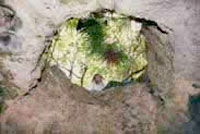 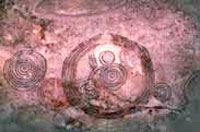 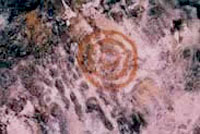
I interpreted the symbolism of these
designs as perhaps embodying the memory of some kind of comet impact
suffered by the Caribbean in a distant epoch. Such thoughts came
entirely from intuitive feelings experienced during a personal visit
to the cave in September 1998 - feelings that led me to explore the
possibility of a comet impact having devastated the region.
More
curiously, Paulina Zelitsky, the director of the ADC team
working out of Cuba, visited the Punta del Este caves for the first
time only shortly before the discovery of the Guanahacabibes site,
off the west coast of Cuba in July 2002. She has since claimed that
an unconfirmed carving of a cross detected on a large, roughly
rectangular block videoed at the underwater site, bears some
similarity to an abstract cross design found inside Punta del
Este’s Cueva # Uno.
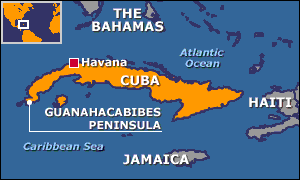
The 1951 ECOS Article
Yet it now appears that as early as 1951, a decade before the advent
of Communist rule on the island, Cuban archaeologists were working
on the theory that the petroglyphs in Punta del Este’s Cueva # Uno’s
reflected some kind of cosmic catastrophe which devastated Atlantis.
A two-page article appeared in the February 1952 edition of the
magazine ECOS entitled ’Formó Cuba Parte de la Atlándida?’. Written
by Francisco Garcia-Juarez, the press secretary of the Instituto
Cubano de Arqueologia (Institute of Cuban Archaeology, or ICA)
it posed the question: did Cuba once form part of Atlantis? He
explained how members of the Institute were investigating the idea
that traces of an Atlantean culture might be found in Cuba and
Hispaniola, a view offered to them by Egerton Sykes, then a
world renowned authority on Atlantis.
In 1949 he had written an introduction
for a revised edition of
ATLANTIS: THE ANTEDILUVIAN WORLD,
the all-time classic on the subject, written by former US
congressman Ignatius Donnelly and published for the first time in
1882.
Sykes was also the editor of a journal propounding Hans Hoerbinger’s
Cosmic Ice theory entitled, simply, ATLANTIS, in which appeared a
partial translation of the above-mentioned ECOS article.
According to Syke’s translation, the ICA concluded that the most
likely location where traces of the Atlantean culture might be found
on Cuba was the Punta del Este cave complex. In one cave was found
steps that led up to an alcove which might possibly have been used
by priests to observe the movement of the stars. Moreover,
petroglyphs inside the caves (presumably those in Cueva # Uno)
displayed astronomical information which linked them with the
origins of the Maya calendrical system, thus the possibility that
Cuba had been a ’staging post’ for the migrations of the Maya into
Central America should not be overlooked. More than this, the
translation stated:
On the South coast of Cuba, at Camaguey, there are many partially
submerged mounds called "caneyes", which may have been places of
refuge for primitive man. There are numerous artifacts here which
have never been adequately investigated. Numerous skeleton remains
found here give evidence of a sudden and violent death due to some
catastrophe. The artifacts include stone balls, spherical stones,
elongated stones, and rods with forked ends resembling snakes. The
absence of large monuments may merely mean they have not yet been
seriously looked for.
Sykes had told the ICA that if Cuba did form part of Atlantis then
its archaeologists would find evidence on the island of artificial
deformation of the cranium among its ancient inhabitants, as well as
step monuments or ziggurats and methods of cutting and orientating
large rocks. Why exactly he felt they would find these things is not
made clear, although I suspect that his theories were based on
Donnelly’s concept of a diffusion of shared ideas among ancient
cultures on both sides of the Atlantic Ocean, due to the suggested
migration of peoples from Atlantis following its destruction.
Whatever the reasons, the archaeologists
confirmed that all of these things had been found on Cuba, but, as
the article stated, there would have to be a revolution of the
established ways of thinking before their presence would be seen as
evidence for the existence of Atlantis.
What was infinitely more important, however, were the
interpretations of the petroglyphs found in the Punta del Este caves
(again, seemingly those in Cueva # Uno) by Cuban archaeologists back
in 1951. Captions accompanying two examples shown as line
illustrations, explained that the symbols showed a comet with a tail
hitting an astral, or celestial, body, and breaking up, confirming
my own theory that the petroglyphs of Cueva # Uno embodied a memory
of a catastrophe caused by the fragmentation of a comet during some
former age. Yet what evidence might we find that the former Bahaman
landmass might once have been home to the same Atlantean culture?
Cayce’s
Psychic Quest
In 1926
Edgar Cayce, America’s most famous psychic, agreed to use
his psychic talents to find buried treasure on the twin-islands of
Bimini, the self-styled ’gateway to the Bahamas’. The wealthy
businessmen involved had asked Cayce to join them in Miami following
some initial readings (all mostly missing now from the Cayce
archives). However, Cayce had said that he could not easily take up
temporary residence in Miami because of his practice at Virginia
Beach. Moreover, in one letter he pointed out that his son was
seriously ill and that he could not possibly make any long journeys
until the boy had regained his full health.
Edgar Cayce and his business associates never did find any buried
treasure on Bimini, even though the psychic made his only ever visit
to the island in February 1927. However, both during the psychic
investigations and afterwards Cayce now began to refer to Bimini as
a surviving fragment of a great landmass called Poseidia, itself
a
surviving portion of a great continent called Atlantis. He predicted
that parts of Poseidia would start to rise off Bimini in ’sixty-eight and sixty-nine, not so far away’.
This led to a concentration of effort by
the Association of Research and Enlightenment (ARE),
the active arm of the Edgar Cayce Foundation, to find evidence of
Atlantis in the shallow waters around Bimini, and in the summer of
1968 this culminated in the discovery of rectangular foundations
(the so-called ’temple site’) in the meter-deep waters off Andros,
the largest island in the Bahamas, as well as
the so-called Bimini
Road site, located off Paradise Point, North Island.
Thus began a relationship between Atlantis and the Bahamas which has
continued now for nearly 35 years, with as many as 60 sites of
possible archaeological interest being noted in its shallow waters.
By far the greatest concentration are found on the south-western
corner of the horseshoe-shaped Great Bahama bank which, although
almost entirely submerged today, was still being swallowed up by the
ocean as late as 3000-2000 BC.
Described by J. Manson Valentine, the
great underwater explorer as the ’mother lode’ of the Bahamas, they
face out across the extremely deep Old Bahama Channel towards
Cuba,
and their presence seems to hint at a connection in prehistory
between these two enormous landmasses. As early as the 1950s light
aircraft pilots flying in and out of Cuba from Miami reported seeing
what appeared to be walls and buildings in the waters north of the
Cuban mainland.
There is no question that if the Bahaman landmass did once support a
prehistoric culture, then it was also present on Cuba as well.
Carved petroglyphs, with skylights in their ceilings to let in
sunlight, stone cairns and age-old human bones have been found in
submerged caves not only on the Great Bahama Bank, but also on its
more northerly neighbor, the Little Bahama Bank. They bear striking
similarities to the decorated caves of Cuba which are at least
several thousand years old, and plausibly much older still. Whoever
inhabited these sites were the descendants of those who survived the
cataclysm, and those who went on to become the ruling class of the
Mesoamerican peoples such as the Olmec, Maya, Quiche, Toltecs and
Aztecs.
Here somewhere is the origins of the
Atlantis myth, and Cuba holds the key to its re-discovery, and one
day we will have all the answers. Whether the stone structures
discovered by ADC in the Yucatan Channel do turn out to be remnants
of lost Atlantis remains to be seen. All we can hope is that the
full extent of the finds is researched and documented, allowing
people to make up their own minds on whether the greatest enigma of
the ancient world has finally been solved.
|





